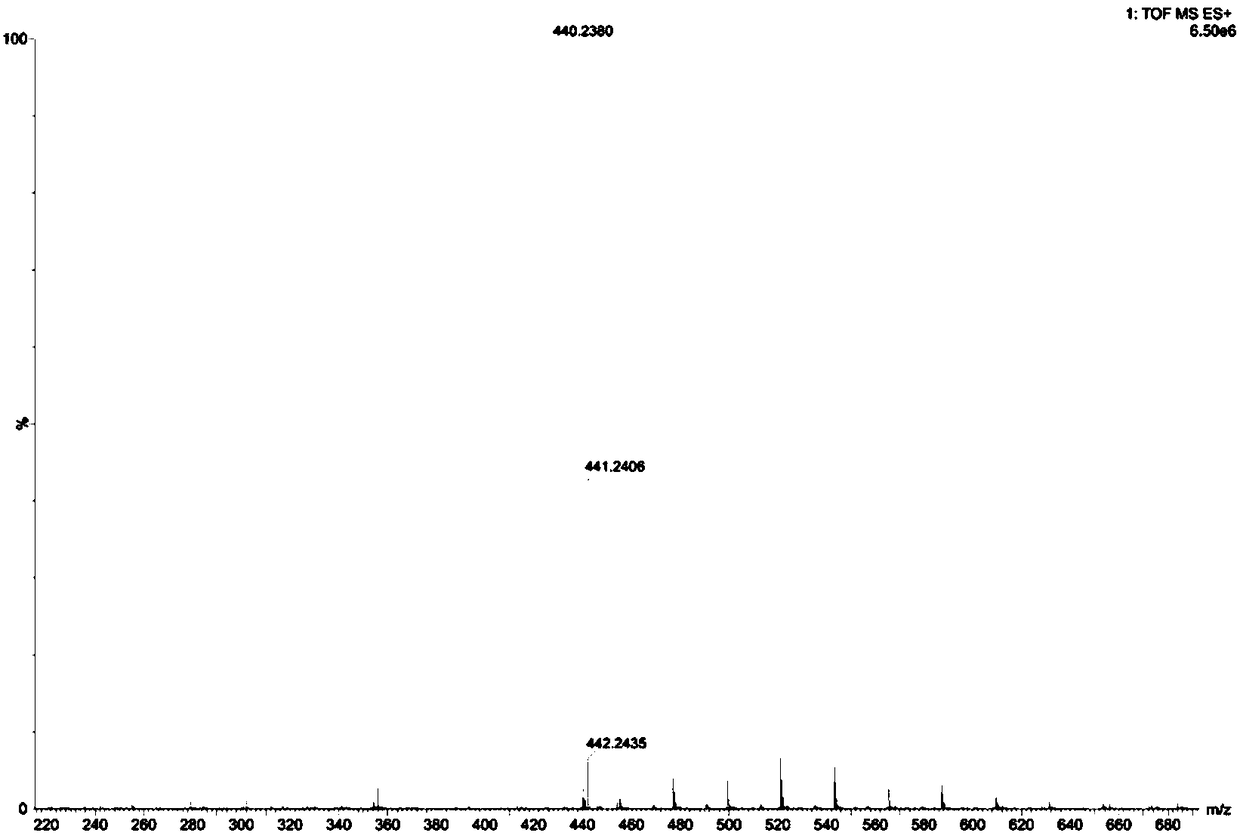Two-photon red-light-emitting fluorescent probe for detecting mitochondria
A fluorescent probe and two-photon excitation technology, applied in fluorescence/phosphorescence, luminescent materials, measurement devices, etc., can solve problems that need to be developed, and achieve the effects of small light damage, deep penetration depth, and low photobleaching effect
- Summary
- Abstract
- Description
- Claims
- Application Information
AI Technical Summary
Problems solved by technology
Method used
Image
Examples
Embodiment 1
[0028] Example 1 Synthesis of Fluorescent Probe HVQ
[0029] Use ethanol as solvent, add 2-methylquinoline, add 1.2 eq iodohexane solution, heat to 80°C for 24 h, after the reaction is completed, cool the reaction system to room temperature, add 1 eq 1-pyrene carboxaldehyde, add 1 eq of pyrrolidine, stirred at room temperature for 12 hours, a large amount of solids precipitated, and the crude product was obtained by filtration. The crude product was redone with absolute ethanol three times, and then recrystallized in ethanol to obtain the pure product 2-(pyrene-1-vinyl )-N-hexyl-quinoline iodonium salt, the productive rate is 48%. product of 1 The H NMR and HRMS spectra are as follows figure 1 with figure 2 Shown: 1 H NMR (400 MHz, DMSO- d 6 ) δ 9.32 (d, J = 15.2 Hz, 1H), 9.19 (d, J = 8.9 Hz, 1H), 9.03 (dd, J = 12.8, 9.1 Hz, 2H), 8.92 (d, J = 8.3 Hz, 1H), 8.63 (d, J = 9.1 Hz, 1H), 8.52 – 8.42 (m, 5H), 8.39 – 8.30 (m, 2H), 8.28 -8.17 (m, 3H), 8.01 (t, J = 7.5 ...
Embodiment 2
[0030] Example 2 Cell Imaging of Fluorescent Probe HVQ
[0031] (1) Cell culture, treatment and staining
[0032] Set the density to 3×10 5 cells / mL of HeLa cells were inoculated into sterile 35 mm imaging culture dishes in CO 2 Incubator (at 37°C, 5% CO 2 ) for more than 12 hours to allow the cells to adhere to the wall. Adherent cells were treated with 4% paraformaldehyde for 30 min to obtain dead cell samples. The DMSO solution of the fluorescent probe prepared in Example 1 with a concentration of 2.5 mM was prepared as the mother solution, and the mother solution was added to the dead and living cell culture dish so that the final concentration was 5 μM. Continue to culture under the same conditions for 1 h, then aspirate the cell culture medium, wash the cells with the medium for 3 times, and then perform the cell imaging experiment.
[0033] (2) Confocal microscope imaging
[0034] The excitation wavelengths were 405 nm and 800 nm respectively, and the collection ...
Embodiment 3
[0035] Example 3 Co-localization of probes and commercial probes in living cells
[0036] In order to further confirm the staining position of the probe HVQ in the cells, we used the commercial mitochondrial dye Mitochondrial Deep Red (MTDR) to perform colocalization staining imaging with HVQ.
[0037] In the live cell colocalization experiment, cells were first stained with 200 nM MTDR for 30 min, then 2 μM HVQ was added to stain cells for 60 min, then the cell culture medium was aspirated, and the cells were washed with medium for 3 times for cell imaging. Use 405 nm as the excitation wavelength, collect the fluorescence at 570-620 nm to collect the fluorescence signal of HVQ; use 647 nm as the excitation wavelength, collect the fluorescence at 663-738 nm to collect the fluorescence signal of MTDR. Get the fluorescence picture as Figure 4 As shown, among them, the Red channel is the HVQ imaging image, the DR channel is the MTDR imaging image, and the Merged channel is the ...
PUM
 Login to View More
Login to View More Abstract
Description
Claims
Application Information
 Login to View More
Login to View More - R&D Engineer
- R&D Manager
- IP Professional
- Industry Leading Data Capabilities
- Powerful AI technology
- Patent DNA Extraction
Browse by: Latest US Patents, China's latest patents, Technical Efficacy Thesaurus, Application Domain, Technology Topic, Popular Technical Reports.
© 2024 PatSnap. All rights reserved.Legal|Privacy policy|Modern Slavery Act Transparency Statement|Sitemap|About US| Contact US: help@patsnap.com










